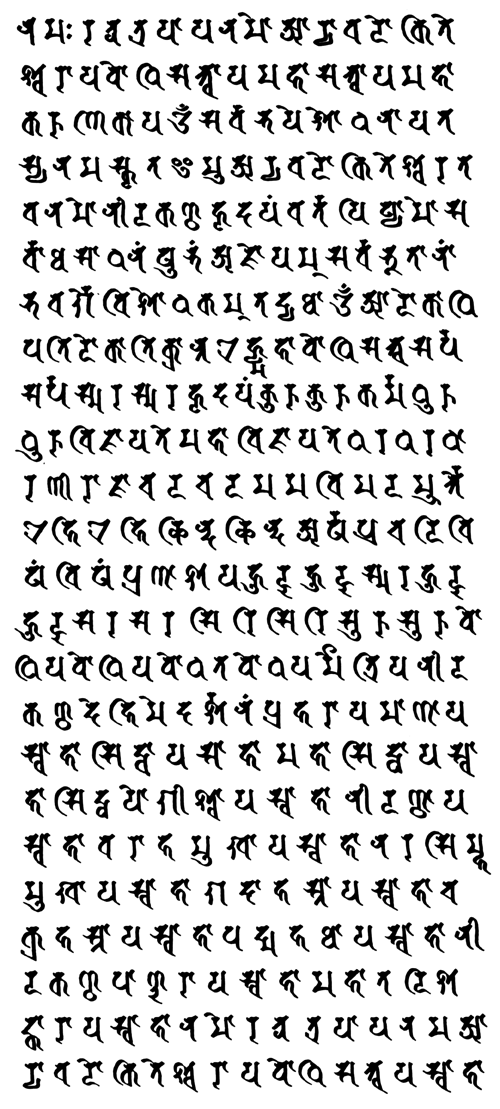The Nīlakaṇṭha Dhāraṇī is also known as the Mahākaruṇika Dhāraṇī. Nīlakaṇṭha means blue-throated, while Mahākaruṇīka means Greatly Compassionate. It is preserved in several versions in the Chinese canon but in each case the Sanskrit is badly corrupted. I use the reconstucted Sanskrit version by Lokesh Chandra working from the various versions in his article Origin of the Avalokitesvara of Potala. The text contains many obvious features assimilated from both Śaiva and Vaiṣṇa milieus - the very name Nīlakaṇṭha is strongly associated with Śiva.


Transliteration
nī la ka ṇṭha dhā ra ṇī
na maḥ ra tna tra yā ya na mo ā ryā va lo ki te
śva rā ya bo dhi sa ttvā ya ma hā sa ttvā ya ma hā
ka ru ṇi kā ya oṃ sa rva bha ye śo dha nā ya ta
sya na ma skṛ ta i mu ā ryā va lo ki te śva ra ta
va na mo nī la ka ṇṭha. hṛ da yaṃ va rta yi ṣyā mo sa
rvā tha sā dha naṃ ṣu bhaṃ a je ya m sa rva bhū tā nāṃ
bha va ma rge vi śo dha kam ta dya thā oṃ ā lo kā dhi
pa ti lo kā ti krā nta e hyma hā bo dhi sa ttva sa rpa
sa rpa sma ra sma ra hṛ da yaṃ ku ru ku ru ka rma dhu ru
dhu ru vi ja ya te ma hā vi ja ya te dha ra dha ra dhā
ra ṇī rā ja ca la ca la ma ma vi ma la mū rtte
e hi e hi chi nda chi nda a rṣa pra c ali vi
ṣaṃ vi ṣaṃ pra ṇā śa ya hu lu hu lu sma ra hu lu
hu lu sa ra sa ra si ri si ri su ru su ru bo
dhi ya bo dhi ya bo dha ta bo dha ya mai tri ya nī la
ka ṇṭha de hi me da rśa naṃ pra ha rā ya mā ṇā ya
svā hā si ddhā ya svā hā ma hā si ddhā ya svā
hā si ddha yo gī śva rā ya svā hā nī la ka ṇṭhā ya
svā hā va rā ha mu khā ya svā hā na ra si mha
mu khā ya svā hā ga dā ha stā ya svā hā ca
kra ha stā ya svā hā pa dma ha thā ya svā hā nī
la ka ṇṭha pā ṇḍa rā ya svā hā ma hā ta li śa
ṅka rā ya svā hā na mo ra tna tra yā ya na ma ā ryā
va lo ki te śva rā ya bo dhi sa ttvā ya svā hā
namaḥ ratnatrayāya
namo āryāvalokiteśvarāya bodhisattvāya mahāsattvāya mahākaruṇikāya
oṃ sarvabhaye śodhanāya tasya namaskṛta imu āryāvalokiteśvara tava namo nīlakaṇṭha. hṛdayaṃ vartayiṣyāmo sarvātha-sādhanaṃ ṣubhaṃ. ajeyam sarvabhūtānāṃ bhava-marge-viśodhakam tadyathā:
oṃ ālokādhipati lokātikrānta ehymahābodhisattva sarpa-sarpa smara smara hṛdayam kuru kuru karma dhuru dhuru vijayate mahāvijayate dhara dhara dhāraṇīrāja, cala cala mama vimala-mūrtte, ehi ehi chinda chinda arṣapracali viṣam viṣam praṇāśaya hulu hulu smara hulu hulu sara sara siri siri suru suru bodhiya bodhiya bodhata bodhaya maitriya nīlakaṇṭha dehi me darśanaṃ. Praharāyamāṇāya svāhā siddhāya svāhā mahāsiddhāya svāhā siddhayogīśvarāya svāhā nīlakaṇṭhāya svāhā varāhamukhāya svāhā narasimhamukhāya svāhā gadāhastāya svāhā cakrahastāya svāhā padmahathāya svāhā nīlakaṇṭhapāṇḍarāya svāhā mahātali-śaṅkarāya svāhā
namo ratnatrayāya nama āryāvalokiteśvarāya bodhisattvāya svāhā
notes
The Nīlakaṇṭha Dhāraṇī was translated into Chinese four times: first by Vajrabodhi (fl. 719-741) Taisho 1112, then twice by his pupil Amoghavajra (ca 723-774) T. 1111, 1113b [link to CBETA romanised version], and lastly in the fourteenth century by Dhyānabhadra T. 1113a. In addition some Chinese and Central Asian texts have been discovered at Dun Huang. Amoghavajra's version (T. 1113A) which is preserved along with a (badly corrupted) Siddhaṃ script Sanskrit version is the most popular form of the dhāraṇī and is popularly chanted in East Asia.
More information on this dhāraṇī and it's variations can be found in Chandra, Lokesh. The Thousand-Armed Avalokitesvara (Avalokiteshvara). Abhinav Publications. 1988. It is available via Google Books.
The blue throat is related to an ancient Indian myth of churning the ocean of milk (samudra manthan) - a contest between the devas and asuras - with the goal of producing amṛta, the nectar of immortality. There are several versions of this story but in some the amṛta becomes poisoned (by the asuras) and in order to prevent all life being destroyed someone drinks it. In some versions is it Śiva who drinks it, in Buddhist legends Vajrapāṇi or Avalokiteśvara. Whoever drinks it, it turns their throat (or in Vajrapāṇi's case his whole body) blue. Hence the name blue (nīla) throated (kaṇtha) (this is an example of a bahuvrīhi compound). Note that the peacock has a blue throat and because it occasionally eats snakes is thoought to be immune to poison.
Many of the epithets in this dhāraṇī are adopted from Śaiva or Vaiṣṇa sources. Names associated with Viṣnu include: padmahasta, vajrahasta, cakrahasta, varāhamuka. As I have pointed out Nīlakaṇṭha is a name for Śiva; we also find siddhayogīśvara. We find many examples of Buddhists purposefully absorbing material, iconography and ritual elements from other religious milieus.
